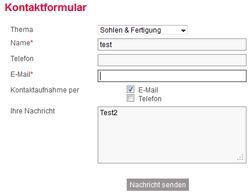

#Powermail template professional#
The usage of a site package is the professional and recommended way, though. Of course you can store the configuration files and templates in every accessible folder on your webserver. Also keep in mind that a site package needs some basic configuration files to work, e.g. Please remember to respect the inner file structure of the templates: The small Partial to mark mandatory fields has to be saved inside Resources/Private/ Frontend/Partials/ Field/Required.html. If you wanted to adjust templates for the backend module, the location would be Resources/Private/ Backend/Templates/. Location for your customized frontend templates. Location for your customized frontend partials. getting a bad request error when selecting a template to associate to a blast. With this file we'll modify form to our needs. Built on the latest version T3v3, K2 component. Configuration/Yaml/CustomFormSetup.yaml Stunning responsive Joomla 3.0 template for technology news websites - JA Brisk.The file structure is based on a typical TYPO3 Extbase extension:Īfter installing the extension, the TypoScript inside this file is automatically loaded. I'll use a site package in this tutorial to store my files. one YAML file to modify the basic configuration of form.

For that, we'll need at least two YAML configuration files: There is an elegant way to achieve custom templates for single forms, though.
#Powermail template download#
Download Free Powerpoint Templates Design now and see the difference. Using TypoScript conditions would be inconvenient. A nd different pertinent information that want to be prepared in a pictogram. But these templates would be used for every form on your website, which is not always desired.
#Powermail template how to#
The documentation mentioned above (working draft) contains an example how to add custom templates. You can find the configuration reference and API reference on the subsequent pages. The general concept of the form extension is described in great detail on this page. You can configure the backend module so that you're able to modify forms that have been outsourced to an extension. This way you can easily version your generated forms and reuse them in other TYPO3 installations. By default these files are saved inside the fileadmin folder by the backend module, but it's possible to save to site packages (template extensions). Every form is saved as a separate YAML file including all form fields, validators and finishers, e.g. One great advantage compared to proven form extensions like powermail is the way forms are stored. Thankfully, the backend module of form contains a quite helpful form editor which assists you with creating a new form. TYPO3 integrators will have to adapt to this new configuration method. Especially for the new form framework, a lot of configuration exists because the core developers wanted it to be as versatile as possible. It is also used for the configuration of the new rich text editor ckeditor. The new form extension is configured entirely with YAML – this markup language was established in the TYPO3 universe with the new version 8.


 0 kommentar(er)
0 kommentar(er)
